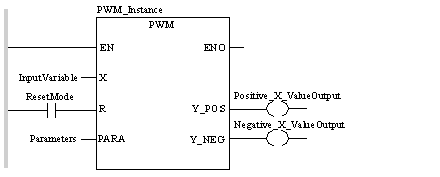|
Description
|
|
|
Original instructions
|

 WARNING WARNING |
|
UNEXPECTED OUTPUT BEHAVIOUR
Make sure that the function block is always invoked in the first program cycle.
Failure to follow these instructions can result in death, serious injury, or equipment damage.
|
|
Output
|
Formula
|
Condition
|
|---|---|---|
|
Y_POS
|
 |
 |
|
Y_NEG
|
 |
 |



CAL PWM_Instance (X:=InputVariable, R:=ResetMode,
PARA:=Parameters, Y_POS=>Positive_X_ValueOutput,
Y_NEG=>Negative_X_ValueOutput)
PWM_Instance (X:=InputVariable, R:=ResetMode,
PARA:=Parameters, Y_POS=>Positive_X_ValueOutput,
Y_NEG=>Negative_X_ValueOutput) ;
|
Parameter
|
Data type
|
Description
|
|---|---|---|
|
X
|
Input variable
|
|
|
R
|
Reset mode ("1" = Reset)
|
|
|
PARA
|
Parameter
|
|
Parameter
|
Data type
|
Description
|
|---|---|---|
|
Y_POS
|
BOOL
|
Output for positive X values
|
|
Y_NEG
|
BOOL
|
Negative X value output
|
|
Element
|
Data type
|
Description
|
|---|---|---|
|
t_period
|
Length of period
|
|
|
t_pause
|
TIME
|
Pause time
|
|
t_brake
|
TIME
|
Braking time
|
|
t_min
|
TIME
|
Minimum actuating pulse time (in sec)
|
|
t_max
|
TIME
|
Maximum actuating pulse time (in sec)
|
|
up_pos
|
Upper limit value for positive X values
|
|
|
up_neg
|
REAL
|
Upper limit value for negative X values
|
